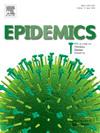Modelling the dynamics of SARS-CoV-2 during the first 14 days of infection
IF 2.4
3区 医学
Q2 INFECTIOUS DISEASES
引用次数: 0
Abstract
Interpreting the viral mechanism of SARS-CoV-2 based on the human body level is critical for developing more efficient interventions. Due to the limitation of data, limited models consider the viral dynamics of the early phase of infection. The Human Challenge Study (Killingley et al., 2022) enables us to obtain data from inoculation to the 14th day after infection, which provides an overview of the dynamics of SARS-CoV-2 infection within the host. In the Human Challenge Study, each volunteer was inoculated with 10TCID50, approximately 55PFU, of a wild-type of virus (Killingley et al., 2022), and the data indicates that the viral load reduced below the detectable level within a day.
The simplified within-host models developed by Xu et al. (2023) explain the data from the Human Challenge Study (Killingley et al., 2022). However, they do not explain the viral decay from Day 0 to Day 1. Hence, in this paper, we aim to develop a new viral mechanism to explain this phenomenon. Based on the simplified within-host models developed by Xu et al. (2023), we consider that the virus will first go through an adjustment phase and then start to replicate. A new dose-response model is developed to evaluate the probability of infection by constructing a boundary problem. We will discuss this viral mechanism and fit the model to the data of the Human Challenge Study (Killingley et al., 2022) by adopting AMC-SMC (approximate Bayesian computation-sequential Monte Carlo). Based on the results of parameter inference, we estimate that the adjusted viral load is around 1% of the inoculated viral load.
模拟SARS-CoV-2在感染的头14天内的动态
基于人体水平解释SARS-CoV-2的病毒机制对于制定更有效的干预措施至关重要。由于数据的限制,有限的模型考虑了感染早期的病毒动力学。人类挑战研究(Killingley et al., 2022)使我们能够获得从接种到感染后第14天的数据,从而概述了宿主内SARS-CoV-2感染的动态。在人类挑战研究中,每位志愿者接种了10TCID50,约55PFU的野生型病毒(Killingley et al., 2022),数据表明病毒载量在一天内降至可检测水平以下。Xu等人(2023)开发的简化宿主内模型解释了人类挑战研究(Killingley等人,2022)的数据。然而,它们并不能解释病毒从第0天到第1天的衰减。因此,在本文中,我们的目标是建立一个新的病毒机制来解释这一现象。根据Xu等人(2023)开发的简化宿主内模型,我们认为病毒将首先经历一个调整阶段,然后开始复制。建立了一种新的剂量-反应模型,通过构造边界问题来评估感染的概率。我们将讨论这种病毒机制,并通过采用AMC-SMC(近似贝叶斯计算-顺序蒙特卡罗)将模型拟合到人类挑战研究(Killingley等人,2022)的数据中。根据参数推断的结果,我们估计调整后的病毒载量约为接种病毒载量的1%。
本文章由计算机程序翻译,如有差异,请以英文原文为准。
求助全文
约1分钟内获得全文
求助全文
来源期刊

Epidemics
INFECTIOUS DISEASES-
CiteScore
6.00
自引率
7.90%
发文量
92
审稿时长
140 days
期刊介绍:
Epidemics publishes papers on infectious disease dynamics in the broadest sense. Its scope covers both within-host dynamics of infectious agents and dynamics at the population level, particularly the interaction between the two. Areas of emphasis include: spread, transmission, persistence, implications and population dynamics of infectious diseases; population and public health as well as policy aspects of control and prevention; dynamics at the individual level; interaction with the environment, ecology and evolution of infectious diseases, as well as population genetics of infectious agents.
 求助内容:
求助内容: 应助结果提醒方式:
应助结果提醒方式:


